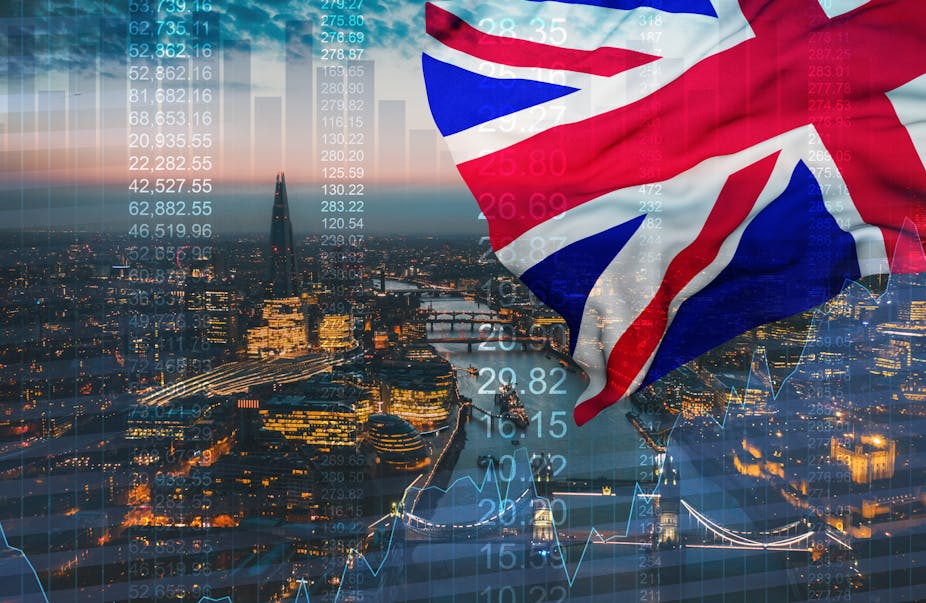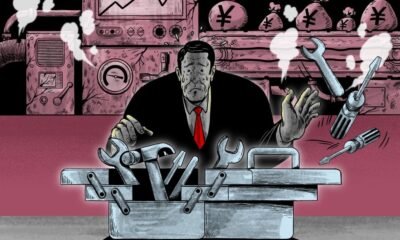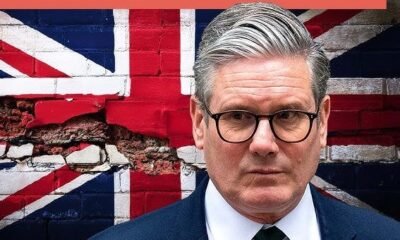Economy
Global Economic Pulse, UK’s Surprise Growth, US Inflation Jumps While China And Japan Battle It Out—Who’s Leading And Who’s Lagging?
U.S. consumer prices saw their sharpest increase in nearly 1-1/2 years in January, signaling persistent inflation pressures that may keep the Federal Reserve from easing interest rates anytime soon
Published
8 months agoon

Inflation, interest rates, and tariffs are shaping 2025 into a crucial year for the global economy. Growth is expected to hover at a “stable yet underwhelming” 3.2%, according to the International Monetary Fund (IMF). However, uncertainty remains the biggest challenge, particularly with the return of Donald Trump to the White House. His chaotic and often unpredictable economic policies—including threats of new tariffs against China, Canada, and Mexico—significantly reshape global trade dynamics.
The US Economy. A Strong Hand-Off, But What’s Next?
The US economy ended 2024 on a strong note, with a 2.5% annual growth rate, supported by a resilient labor market and robust consumer spending, which accounts for nearly 70% of economic activity. Business investment also played a role in this expansion, though it faltered in the final months of the year.
According to the latest Commerce Department data, the economy grew at an annualized rate of 2.3% in Q4 2024, slightly below economists’ expectations. Meanwhile, the Federal Reserve has maintained its key interest rate after three consecutive rate cuts last year. While Fed Chair Jerome Powell signaled optimism about the economy’s strength, he also warned that beneath the surface, pockets of economic distress remain.
Inflation Pressures Mount
U.S. consumer prices saw their sharpest increase in nearly 1-1/2 years in January, signaling persistent inflationary pressures that may keep the Federal Reserve from easing interest rates anytime soon. According to the latest report from the Labor Department, a combination of price hikes across goods and services, including prescription medications and motor vehicle insurance, contributed to the surge, reinforcing concerns about economic uncertainty in 2025.
The Consumer Price Index (CPI) jumped 0.5% in January, the biggest monthly gain since August 2023, following a 0.4% rise in December. Over the past year, inflation climbed to 3.0%, the largest increase since June 2024. While economists had anticipated a 0.3% monthly increase and a 2.9% annual rise, the actual figures exceeded expectations, adding to inflation worries.
Shelter costs, which make up nearly a third of the CPI, rose 0.4%, marking the third consecutive monthly gain. Food prices also saw a sharp uptick, increasing by 0.4% overall, with grocery store prices surging 0.5%. Egg prices skyrocketed by 15.2%—their largest spike since June 2015—due to an avian flu outbreak, while prices for meats, poultry, and dairy products also increased.
Meanwhile, gasoline prices rose by 1.8%, and natural gas costs increased by the same percentage, though electricity prices remained unchanged.
Fed’s Response and Market Reaction
Federal Reserve Chair Jerome Powell emphasized that the latest CPI data illustrates the need for caution before considering interest rate cuts. “We’re not quite there yet,” Powell stated during a congressional testimony, reaffirming the Fed’s commitment to bringing inflation back to its 2% target.
Financial markets responded swiftly to the inflation report. Stocks on Wall Street tumbled, the U.S. dollar weakened against a basket of currencies, and Treasury yields climbed as investors recalibrated their expectations for future rate cuts.
The Federal Reserve maintained its benchmark overnight interest rate in the 4.25%-4.50% range in January, following a series of rate cuts totaling 100 basis points since September. This came after the aggressive monetary tightening of 2022 and 2023, where rates were hiked by 5.25 percentage points to combat inflation. However, with inflationary trends showing renewed strength, expectations for further easing have significantly weakened.

China
While the U.S. struggles with inflation concerns, China faces the opposite challenge—persistent deflationary pressures. Analysts predict that unless Beijing takes aggressive measures to boost domestic demand, deflation could remain a major issue throughout 2025. U.S. tariffs on Chinese goods add another layer of complexity, placing additional stress on China’s struggling economy.
China’s consumer inflation reached its highest level in five months in January, rising 0.5% year-over-year, up from a 0.1% increase in December. Core inflation, which excludes food and fuel, accelerated to 0.6% in January from 0.4% the previous month. However, factory gate prices remained deflationary, with the producer price index (PPI) declining 2.3% in January—its 28th consecutive month in negative territory.
Seasonal factors also played a role in China’s inflation dynamics. The Lunar New Year, which fell in January this year, drove up consumer demand for goods and services. Airfare prices rose by 8.9% year-over-year, while tourism-related costs surged by 7.0%. Movie and performance ticket prices spiked 11.0% as holiday spending picked up. Despite these short-term increases, broader consumer spending remains muted, reflecting concerns over wage growth and job security.
Looking ahead, China’s policymakers are expected to maintain an economic growth target of around 5% for 2025. However, fresh U.S. tariffs threaten to undermine China’s export sector, which was one of the few bright spots in an otherwise sluggish economy last year. The Chinese government is unlikely to introduce any major monetary or fiscal policy changes before its annual parliamentary session in March, as officials assess both domestic and external risks.
Japan
Japan’s annual wholesale inflation surged to a seven-month high of 4.2% in January, marking its fifth consecutive month of acceleration. The data shows persistent price pressures, reinforcing market expectations that the Bank of Japan (BOJ) could raise interest rates again this year.
The inflation spike follows a warning from BOJ Governor Kazuo Ueda, who cautioned that rising food costs could shape public inflation expectations, highlighting the central bank’s concern over sustained price increases. While policymakers remain wary of inflationary risks, analysts are divided on whether the BOJ will be able to tighten its monetary policy without dampening consumer sentiment.
Inflationary Pressures vs. Consumer Weakness
Rising wages have provided some cushion against inflation, but elevated food and energy prices continue to weigh on household spending. Takeshi Minami, chief economist at Norinchukin Research Institute, pointed out that despite wage growth, consumers remain cautious, which could deter the BOJ from rushing into further rate hikes.
The latest inflationary surge was driven not only by higher energy prices, exacerbated by the phase-out of government subsidies, but also by broad-based increases in the costs of textiles, plastics, and non-ferrous metals. Import costs also climbed, with yen-based import prices rising 2.3% in January after a revised 1.4% increase in December, as the weaker yen continued to inflate expenses for Japanese firms.
Impact of U.S. Policy on Japan’s Economic Outlook
Expectations of prolonged higher interest rates in the U.S. have further pressured the yen, pushing it to 154.44 per dollar, its weakest level in a week. The impact was felt in Japan’s bond market, with the benchmark 10-year government bond yield briefly reaching a 15-year high of 1.37% before settling at 1.365%.
Analysts attribute the upward movement in Japanese bond yields to rising U.S. Treasury yields and uncertainty surrounding potential tariff policies under U.S. President Donald Trump. Market expectations suggest an 80% probability of a BOJ rate hike in July, though some strategists believe inflationary pressures could prompt a move even sooner.
How Far Will the BOJ Go?
While Japan has only recently exited a decade-long ultra-loose monetary policy, the BOJ’s decision in January to raise short-term rates to 0.5% signals a shift towards normalization. With core consumer inflation hitting 3.0% in December—marking its fastest annual pace in 16 months and staying above the BOJ’s 2% target for nearly three years—further tightening remains a strong possibility.
Still, economists caution that the BOJ is unlikely to adopt an aggressive stance. Naomi Muguruma, chief bond strategist at Mitsubishi UFJ Morgan Stanley Securities, noted that while demand-driven inflation remains limited, rising costs for raw materials and labor could prompt the BOJ to lift rates further, albeit at a measured pace.
A recent private survey indicated that most economists expect the BOJ to raise short-term rates to 0.75% in the latter half of the year, though projections remain unchanged from last month’s outlook. For now, the BOJ remains in a delicate balancing act—addressing inflation while ensuring that rate hikes do not stall economic momentum.

United Kingdom
The UK economy surprised analysts by posting a modest 0.1% growth in the fourth quarter of 2024, defying expectations of a 0.1% contraction. This unexpected upturn offers some respite to Finance Minister Rachel Reeves, though deeper structural challenges persist.
Economists were bracing for a contraction, but December’s stronger-than-expected 0.4% growth lifted the overall quarter. For the year 2024, GDP expanded by 0.9%, an improvement from 0.4% in 2023. However, when adjusted for population growth, per capita GDP declined by 0.1%, underscoring continued pressure on living standards and public finances.
The announcement had an immediate impact on financial markets, with the British pound strengthening against the U.S. dollar.
The December surge was primarily driven by the services sector, with wholesalers, film distributors, pubs, and bars performing well. Additionally, machinery manufacturers and pharmaceutical firms contributed positively. However, the data also revealed a reliance on government spending and an inventory buildup by companies, which may prove temporary. Notably, business investment saw a sharp 3.2% quarterly drop, and household spending remained flat.
The decline in business investment was largely attributed to transport equipment, a particularly volatile category that had performed strongly in the third quarter.
A Tough Road Ahead
While the short-term growth numbers provide some relief, the overall economic outlook remains challenging. The Bank of England recently halved its 2025 growth forecast to 0.75%, though the National Institute of Economic and Social Research is more optimistic, predicting 1.5% growth.
The UK economy had shown moderate growth in early 2024, rebounding from a shallow recession in late 2023. However, momentum slowed in the latter half of the year, with zero growth recorded in the third quarter. Businesses have raised concerns over the impact of the Labour government’s £25-billion rise in employment taxes announced in the October 30 budget, with some warning of staff cuts and price hikes as a response.
Reeves and Prime Minister Keir Starmer have pledged to remove planning and regulatory barriers to stimulate growth, with Reeves reiterating their commitment: “We are taking on the blockers to get Britain building again, investing in our roads, rail, and energy infrastructure, and removing the barriers that get in the way of businesses who want to expand.”
The Conservative opposition remains critical, arguing that the fall in GDP per capita signals a “recession in living standards” even if overall economic growth remains positive.
Adding to the concerns, higher borrowing costs and a sluggish economic climate could force Reeves to implement spending cuts to adhere to the government’s borrowing rules when updated forecasts are released next month.
While the UK economy has momentarily defied recession fears, significant hurdles remain in the path to sustainable growth.
You may like
-


Taiwan’s ‘Historic’ TSMC Deal, A Win Or The End Of Its ‘Silicon Shield’ As China Threatens? A Jittery Taiwan Watches Trump’s Moves On Ukraine, Wondering, Could We Be Next?
-


America And China’s Thirst For Gold In 2025 Is Draining Other Countries’ Reserves; Here’s Why?
-


China To Cut Inflation Outlook To 20-Year Low, Eyes Fresh Stimulus At ‘Two Sessions’ To Boost Economy
-


Trump’s Latest Tariff Move on Mexico and Canada. Import Taxes Back on Track Hinting At A Full Blown Trade War!
-


Germany’s Friedrich Merz’s Big Balancing Act—Trump, Borders & Europe’s Future. Can He Deliver?
-


United Kingdom To Unleash Its ‘Harshest’ Sanctions On Russia Yet—But Will They Bite? How Trouble Is Brewing For Keir Starmer At Home. Shamed For Volunteering British Troops In Ukraine
